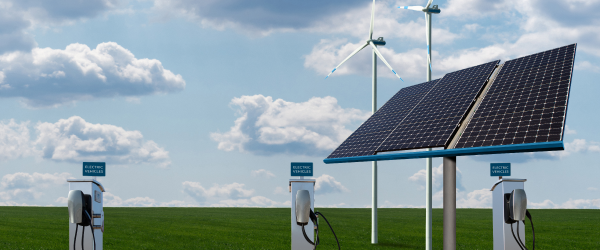Global listed infrastructure companies outperformed both global equities and bonds in 2022.
We believe the financial and economic factors contributing to this outperformance may remain in play in 2023.
Slower global economic growth is likely in 2023, with recession risks high enough for it to be the base case in our valuation models. We believe the UK and the European Union are already in recession with a mild recession likely in the US in the year ahead. China could be an outlier with a steady acceleration in growth as the country winds back its COVID Zero policy and gradually reopens to the world.
Meanwhile, the elevated inflation seen in 2022 is likely to remain a feature in economies and financial markets in 2023. Infrastructure companies can outperform broader equities and fixed income markets in periods of slowing economic growth and higher inflation, given they tend to provide essential services, have strong pricing power and often high barriers to entry and predictable cash flows.
We estimate more than 70% of the assets within FSI global listed infrastructure portfolios are able to pass through inflationary pressures to the end customer. We expect the asset class to deliver mid-single digit EBITDA, EPS and DPS growth p.a. over the next two years.
These factors are likely to combine with five additional themes which could add support to certain pockets within the asset class.
1. The ‘Russia Pivot’ - LNG to the rescue
The Russia-Ukraine war reinforced the importance of energy independence and security for many countries.
With more than 40% of Europe’s gas coming from Russia, the invasion of Ukraine created an energy crisis. Commodity prices rose sharply as a result, and demand for alternative sources of Liquefied Natural Gas (LNG) accelerated. The graph below illustrates recent growth in US LNG exports to Europe.
The US substantially increased its LNG exports to Europe
US infrastructure companies with LNG export facilities such as US-listed Cheniere Energy and Sempra Energy outperformed in this environment. As a reliable and relatively cheap source of gas, new long-term contracts for US LNG are likely in the coming years.

2. Government support for infrastructure upgrades
Public policy support for infrastructure investment is likely to remain strong globally, especially where it relates to the replacement of aged infrastructure assets, the buildout of renewables to help decarbonise electricity generation, and the globalisation of natural gas markets.
We also expect private sector funding of new infrastructure investment to remain strong in 2023, although rising interest rates will likely see M&A activity slow. A robust pipeline of capital investment opportunities for the vast majority of global listed infrastructure companies for the year ahead is likely.
In the US, listed infrastructure stocks benefited from the introduction of the Inflation Reduction Act (IRA). The Act is a sweeping climate initiative which commits more than US$369 billion to subsidies and tax credits over a decade1. It seeks to encourage decarbonisation and cleaner energy, including measures to support the development of hydrogen as a fuel source.
We expect the IRA will encourage global capital to move increasingly towards US-based projects, to the benefit of US utilities. However, higher capex will need to be managed in the context of affordability, reliability and sustainability.

3. Decarbonisation: the multi-decade growth opportunity
Investment opportunities from decarbonisation, resiliency, safety, digitalisation and electrification among utilities in particular are large and accelerating. These investments are driving an increase in the rate base growth of utilities globally, which in turn drives earnings growth.
Within utilities, we are seeing an acceleration of solar and battery investments – especially in the US, following the previously mentioned IRA. We are also seeing an increased focus on the decarbonisation of natural gas via Renewable Natural Gas and (in the longer term) hydrogen.
Optimism on earnings growth potential for the decarbonisation of the utilities sector is tempered in the short term by higher debt costs and by increased regulatory and political risks.
Gas prices reinforcing shift to renewables
$/MWh
Higher energy prices means electric and natural gas utility customers face 20-30% higher bills in early 2023, although this pressure may reduce as we move through the year.
Higher utility bills also increase the political and regulatory risks for the sector globally, with the potential for increased government intervention in utility markets in the form of new “windfall” taxes, price caps and government-led investment to reduce price pressure on voters.

4. Everyone needs more data
The outlook for cell towers and data centres remains positive, albeit rising interest rates may be more of a headwind to earnings per share growth than in previous years.
In the US, tower companies are benefiting from increased activity from telecom carriers deploying spectrum to support new 5G networks. The result is increased revenue with little to no additional cost to the tower company. The European tower market remains attractive with multiple M&A opportunities through mobile phone operators selling their tower assets to independent tower companies.
Consumers and businesses continue to move activities onto digital platforms which underpins demand for capacity on communications infrastructure such as cell towers and data centres.
In 2023, we expect carriers and mobile network operators to continue the multi-year rollout of 5G mobile technology which will require tower leasing. With data centres, we expect enterprises to seek efficiencies in IT architectures through a combination of colocation (facilities in which users operate their own data centre hardware) and cloud (the delivery of computing services, run from the cloud provider's data centre) services. The benefit of inflation-linked contracts will be especially evident in European towers.
5. Return of the traveller
The transport sector was focused on volume recovery in 2022, with most toll roads returning towards 2019 levels of traffic, and airport activity up significantly as COVID restrictions eased and ‘revenge’ travel began.
We expect the underlying recovery in demand to continue in 2023, but remain cautious of the economic headwinds globally as higher interest rates and inflationary pressure on the cost of living starts to bite.
We continue to expect global air traffic to recover in 2024-25, but we remain selective in our exposure to the sector and favour leisure-led airports with strong incumbent low cost airlines.
We believe that business travel is likely to remain under pressure in 2023 as a result of high ticket prices, particularly from the legacy carriers who are in the process of repaying state aid and repairing their balance sheets.
Low cost carriers’ push for scale and growth post-COVID will likely see ticket pricing ease to support continued passenger growth in the event of signs of a weakening consumer demand. This should be supportive of airport earnings as they apply the same passenger charge irrespective of the airline.
The majority of toll road operators will benefit from their inflation-linked toll escalators in 2023, with many developed market toll roads set for year-on-year increases in tolls of between 4% and 7%. This will be highly supportive for earnings growth, and whilst we expect an element of demand destruction from these increases, toll roads have demonstrated their highly favourable demand elasticity in the past.
Conclusion
We believe Global listed infrastructure remains well positioned as it enters 2023 with its well-known positive attributes of pricing power, structural growth and resilient cash flows intact. Even if economic growth slows in 2023, the asset class is likely to still deliver highly attractive returns for investors.
We remain convinced the best approach to capture this opportunity is to focus on bottom-up stock selection and the enduring appeal of inflation protected income together with structural-led growth should prove compelling for investors for many years to come.
Global listed infrastructure insights
Important Information
This material has been prepared and issued by First Sentier Investors (Australia) IM Ltd (ABN 89 114 194 311, AFSL 289017) (FSI AIM), which forms part of First Sentier Investors, a global asset management business. First Sentier Investors is ultimately owned by Mitsubishi UFJ Financial Group, Inc (MUFG), a global financial group. A copy of the Financial Services Guide for FSI AIM is available from First Sentier Investors on its website.
This material contains general information only. It is not intended to provide you with financial product advice and does not take into account your objectives, financial situation or needs. Before making an investment decision you should consider, with a financial advisor, whether this information is appropriate in light of your investment needs, objectives and financial situation. Any opinions expressed in this material are the opinions of the Author only and are subject to change without notice. Such opinions are not a recommendation to hold, purchase or sell a particular financial product and may not include all of the information needed to make an investment decision in relation to such a financial product.
Any opinions expressed in this material are the opinions of the individual author at the time of publication only and are subject to change without notice. Such opinions: (i) are not a recommendation to hold, purchase or sell a particular financial product; (ii) may not include all of the information needed to make an investment decision in relation to such a financial product; and (iii) may substantially differ from other individual authors within First Sentier Investors.
To the extent permitted by law, no liability is accepted by MUFG, FSI AIM nor their affiliates for any loss or damage as a result of any reliance on this material. This material contains, or is based upon, information that FSI AIM believes to be accurate and reliable, however neither MUFG, FSI AIM nor their respective affiliates offer any warranty that it contains no factual errors. No part of this material may be reproduced or transmitted in any form or by any means without the prior written consent of FSI AIM.
Any performance information has been calculated using exit prices after taking into account all ongoing fees and assuming reinvestment of distributions. No allowance has been made for taxation. Past performance is not indicative of future performance.
Copyright © First Sentier Investors
All rights reserved.
Get the right experience for you
Your location :  Australia
Australia
Australia & NZ
-
 Australia
Australia -
 New Zealand
New Zealand
Asia
-
 Hong Kong (English)
Hong Kong (English) -
 Hong Kong (Chinese)
Hong Kong (Chinese) -
 Singapore
Singapore -
 Japan
Japan


















 United Kingdom
United Kingdom 